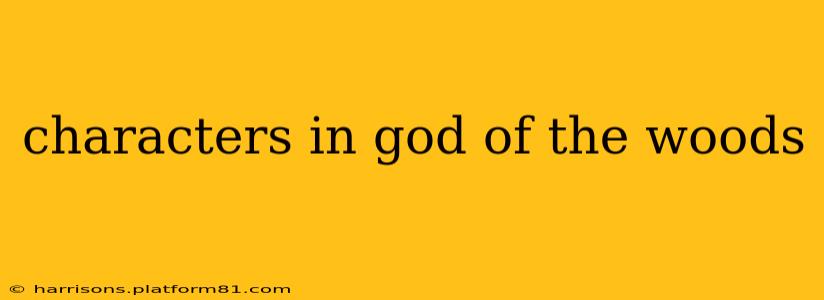"God of the Woods," while not a single, universally recognized title (it could refer to various mythologies' forest deities), often evokes the pantheon of nature spirits and powerful beings associated with woodlands and wilderness in diverse cultures. This exploration delves into the archetypes and recurring characters found in stories centered around the "God of the Woods," examining their roles, motivations, and significance within their respective narratives.
The God/Goddess of the Woods Themselves: A Diverse Pantheon
The central figure, the "God of the Woods," is rarely a singular entity. Different cultures have their own versions, reflecting their unique beliefs and perspectives on nature. These deities often embody aspects of:
- Protection and Abundance: Providing for the needs of the forest and its inhabitants, ensuring a bountiful harvest, and shielding creatures from harm. Think of Pan in Greek mythology, or the various Green Men figures found in medieval art and folklore.
- Wildness and Untamed Power: Representing the untamed, chaotic forces of nature. These deities can be both benevolent and capricious, capable of great generosity and devastating destruction. Examples include the Slavic Leshy or the Japanese Kodama.
- Wisdom and Ancient Knowledge: Often depicted as wise, ancient beings who possess deep knowledge of the natural world and its secrets. These figures might act as guides or mentors, imparting their knowledge to those worthy.
This diversity underscores the multifaceted nature of the archetype, highlighting the cultural and individual interpretations of nature's power.
Common Supporting Characters: Guardians and Inhabitants
Beyond the central deity, numerous other characters populate the narratives surrounding the "God of the Woods." These often include:
- Forest Spirits: Nymphs, dryads, sprites, and other nature spirits are frequently encountered, each with unique roles and personalities. They may be benevolent guardians of the forest or mischievous tricksters.
- Animals: Animals often serve as messengers, allies, or even manifestations of the God of the Woods themselves. Think of the stag frequently associated with woodland deities or the owl as a symbol of wisdom.
- Humans: Humans often interact with the God of the Woods, sometimes as worshipers, sometimes as trespassers. Their relationships with the deity can range from harmonious coexistence to conflict and even persecution.
- Antagonists: Forces that threaten the balance of the forest often appear, such as evil sorcerers, destructive giants, or even representatives of encroaching civilization.
How do these characters interact?
The interplay between these characters is central to the narrative. Stories often explore themes of:
- Human impact on nature: Examining the consequences of human actions on the environment and the potential for conflict or reconciliation between humanity and nature.
- The balance of nature: Illustrating the delicate equilibrium between the different elements of the ecosystem and the consequences of disrupting that balance.
- Spiritual growth and transformation: Showcasing how encounters with the God of the Woods and other supernatural beings can lead to personal growth, spiritual awakening, or a deeper understanding of the natural world.
What are some examples of specific Gods of the Woods?
- Pan (Greek): A half-man, half-goat deity associated with wildness, shepherds, and rustic music.
- Cernunnos (Celtic): A horned god often depicted with animals, representing abundance and fertility.
- Leshy (Slavic): A forest spirit who can be both benevolent and malevolent, acting as a protector or a dangerous trickster.
This exploration highlights that the term "God of the Woods" encompasses a broad range of mythological figures and narratives. Each culture's interpretation offers unique insights into their relationship with the natural world and the power they ascribe to the forces of the forest. The common thread across all these interpretations, however, is the powerful connection between the divine and the natural world, constantly reminding us of our place within the larger ecosystem.
